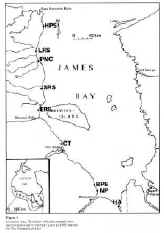|
Geoscience Canada, Vol. 7, No. 1 (1980), 11-21
COASTAL STUDIES IN JAMES BAY, ONTARIO
I.P. MARTINI1, R.I.G. MORRISON2, W.A. GLOOSCHENKO3,
and R. PROTZ1
1Land Resource Science, University of Guelph, Guelph, Ontario N1G 2W1
2Canada Wildlife Service, Ontario Region, Ottawa, Ontario
3Canada Centre for Inland Waters, Burlington, Ontario
กก
 Interdisciplinary
studies have endeavored to understand the geomorphology, sediments, soils,
vegetation, and wildlife of the Ontario coast of James Bay, which is
unique for its fast emergence (70 to 100 cm/century) related to
post-glacial isostatic rebound. From a geomorphologic-sedimentological
point of view, the coast has many similarities to other mesotidal
settings, although typical features due to ice-rafting and scouring of
arctic and subarctic areas are recorded in thin (3 m) sedimentary
sequences. Gleysolic soils form in its low-lying wetlands, and Regosolic
soils evolve into Podzolic soils on sandy and gravelly beach ridges as
they emerge and become forested.
Interdisciplinary
studies have endeavored to understand the geomorphology, sediments, soils,
vegetation, and wildlife of the Ontario coast of James Bay, which is
unique for its fast emergence (70 to 100 cm/century) related to
post-glacial isostatic rebound. From a geomorphologic-sedimentological
point of view, the coast has many similarities to other mesotidal
settings, although typical features due to ice-rafting and scouring of
arctic and subarctic areas are recorded in thin (3 m) sedimentary
sequences. Gleysolic soils form in its low-lying wetlands, and Regosolic
soils evolve into Podzolic soils on sandy and gravelly beach ridges as
they emerge and become forested.
The vegetation of the marshes is typical of subarctic areas. The most
common colonizing plants of intertidal zones are Puccinellia
phryganodes in salt marshes, and Hippurus vulgaris in brackish
marshes. Associated with large rivers, inverted marshes occur with
brackish zones near the shoreline, and saltier zones inland due to
evaporation of waters brought in by storm surges. The fauna of this coast
ranges from numerous mosquitoes and other insects, to invertebrates, to
migratory birds. The shore has irreplaceable international importance
because it contains the breeding and feeding grounds of the migratory
avifauna of central and eastern America. Tens of thousands of shorebirds
and waterfowl feed on specific parts of the ecosystem depending on their
food requirements and their anatomical limitations imposed by depth of
burrowing of infauna, depth of water in marsh pools, and height of
vegetation in different marshes at different times of the year.
Whereas studies of
this virgin, rapidly changing environment can help in understanding and
perhaps managing the wildlife resource, and in predicting the response of
the coastal zone to future human activities, such as regulation and
diversion of rivers, all these processes leave their imprints in the
sedimentary and soil sequences. In sedimentological terms the study of
this coast will lead to a definition of a recognizable model of a cold,
brackish, shallow, regressive, inland sea similar to those that have
occupied this area during Pleistocene times, or other more ancient,
emergent, glacial, arctic basins.
กก
|